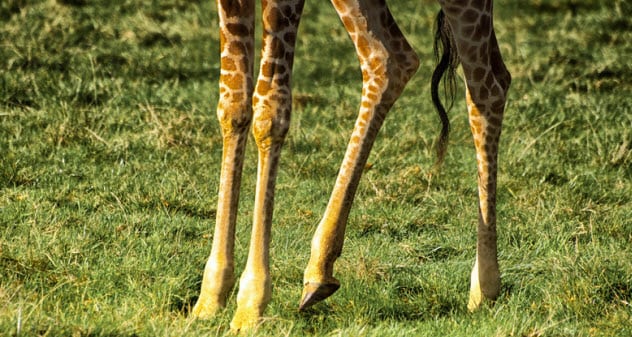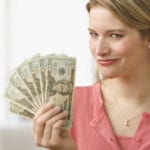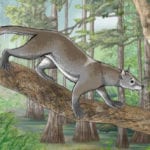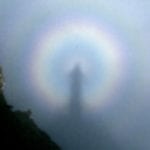 Weird Stuff
Weird Stuff  Weird Stuff
Weird Stuff  Our World
Our World 10 Ways Your Christmas Tree Is More Lit Than You Think
 Movies and TV
Movies and TV The 10 Coolest Stars to Set Sail on The Love Boat
 History
History 10 Things You Didn’t Know About the American National Anthem
 Technology
Technology Top 10 Everyday Tech Buzzwords That Hide a Darker Past
 Humans
Humans 10 Everyday Human Behaviors That Are Actually Survival Instincts
 Animals
Animals 10 Animals That Humiliated and Harmed Historical Leaders
 History
History 10 Most Influential Protests in Modern History
 Creepy
Creepy 10 More Representations of Death from Myth, Legend, and Folktale
 Technology
Technology 10 Scientific Breakthroughs of 2025 That’ll Change Everything
 Weird Stuff
Weird Stuff Ten Bizarre Facts About The Doge Meme
 Our World
Our World 10 Ways Your Christmas Tree Is More Lit Than You Think
 Movies and TV
Movies and TV The 10 Coolest Stars to Set Sail on The Love Boat
Who's Behind Listverse?

Jamie Frater
Head Editor
Jamie founded Listverse due to an insatiable desire to share fascinating, obscure, and bizarre facts. He has been a guest speaker on numerous national radio and television stations and is a five time published author.
More About Us History
History 10 Things You Didn’t Know About the American National Anthem
 Technology
Technology Top 10 Everyday Tech Buzzwords That Hide a Darker Past
 Humans
Humans 10 Everyday Human Behaviors That Are Actually Survival Instincts
 Animals
Animals 10 Animals That Humiliated and Harmed Historical Leaders
 History
History 10 Most Influential Protests in Modern History
 Creepy
Creepy 10 More Representations of Death from Myth, Legend, and Folktale
 Technology
Technology 10 Scientific Breakthroughs of 2025 That’ll Change Everything
Top 10 Interesting Things About The People Of Pompeii
On August 24, AD 79, the inhabitants of Pompeii were going about their daily lives, unaware that they were living their last hours. Earthquakes and tremors had been happening for days. But since Mount Vesuvius had not erupted in hundreds of years, people had become quite familiar with the quakes that happened in the region and, unfortunately, continued with their daily activities until early afternoon.
Eruptions deluged inhabitants six times over the course of two days. Each subsequent explosion was releasing deadly, superhot gases and ash along with a rain of volcanic fallout, followed by a pyroclastic surge and flow which is more lethal than lava due to its high temperature and speed. When it was all over, an estimated 6 meters (20 ft) of volcanic debris and ash had buried Pompeii and its inhabitants.
After being entombed in ash for more than 1,900 years, the unearthed victims of Pompeii have been brought to life with modern-day imaging technology, allowing us to learn from a civilization frozen in time.
10 Pompeiians Were Flash-Heated To Death

Until recently, the primary assumption was that victims had suffered from asphyxiation resulting from the deadly volcanic gases and ash. But a recent study by volcanologist Giuseppe Mastrolorenzo and his colleagues found that hundreds of fatalities occurred during the fourth pyroclastic surge, which was the first to reach Pompeii.
They determined that the surge deposited much less ash than previously thought—about 3 centimeters (1 in) deep. However, the temperatures were at least 300 degrees Celsius (570 °F), which killed people instantly.[1]
9 About Three-Quarters Of Pompeiians Were Frozen In Suspended Actions

The people’s poses reveal how they died, some trapped in buildings and others sheltering with family members. Children and adults have been found encased in ash.
A plaster cast technique—and in one case, a resin cast—has been used to preserve the details within the victims’ ash tombs. Although the soft tissues decayed long ago, each skeleton remains in the void. So they are not statues or replicas but the actual corpses. The skeletons are still in there.
Only 86 casts of victims exist out of the approximate 2,000 dead. Conditions for creating a cast are rare, which explains why they do not exist for all the remains found. Excavations are still occurring at Pompeii today. But plaster damages the fragile remains of the corpses, so archaeologists are no longer producing casts of bodies.
Not only were the positions of the victims captured, but their facial expressions showed the agonies of their deaths.
One victim has his hands raised above his head in a protective gesture—a weak, reflexive attempt to stave off impending doom. Another’s face is frozen in a perpetual scream, reflecting a perfectly preserved mouthful of teeth.
Arms outstretched, a terrified mother and her child meet their deaths. One person is sitting with his hands covering his face as though accepting what is to come. Others are seen crawling as if trying to escape their inevitable fate. Meanwhile, some are found curled in the fetal position or hugging their loved ones in a tragic embrace.[2]
No one knows how he will spend his last minutes if faced with such a terrifying prospect. Yet for one person, there is much debate about his choice. He is found lying on his back, legs spread, with his hand on his nether regions. So, although most of these unearthed victims reflect haunting depictions of how they faced their final, horrifying moments of life, one victim may have chosen to go out in a very different fashion.
8 Garden Of The Fugitives Contains The Most Victims

Of the estimated 2,000 inhabitants of Pompeii believed to have perished in the disaster, archaeologists have unearthed only about 1,150 bodies. This means that the majority of the city’s 20,000 inhabitants escaped when the volcanic activity started.[3]
The Garden of the Fugitives holds the most victims found in a single location. Thirteen people perished there as they sought refuge. The House of Mysteries contained nine sets of other remains, where it is believed that the roof collapsed and trapped these individuals. The Stabian Thermal baths and fish market each contained two more victims, and the Olitorium (market) had several more.
7 Animal Companions Of Pompeiians

Several animals have been found at Pompeii. As it was a prosperous city, many residents had pets, namely dogs. However, most wealthy residents also had horses, and there were farm animals for food as well. Additionally, wild animals roamed the surrounding area. They did not escape and were also doomed.
At the Olitorium (market), a pig was found. There was also a small dog in a collar—presumably, someone’s pet—which was on its back with its legs contorted as though the animal’s last moments were spent writhing in pain.
It is surmised that the owners chained up poor Fido in the atrium and that he managed to survive the first phase of the eruption by climbing up the ash and pumice as it built up in the house. He was finally killed while straining at his chain, trying to escape his confinement when the fourth surge reached Pompeii.
The owners may have left the dog behind to protect their valuables with the hopes of returning when it was safe. Instead, this action doomed poor Fido to his terrible end.
Archaeologists recently found several horses in the stable of a Pompeii villa. It seems that at least three horses perished, two of which were harnessed and possibly prepared for a frantic evacuation. Sadly, they never made it. The harness left traces of valuable iron and bronze by the animal’s head, leading archaeologists to believe that the horse was of considerable value. More than likely, it was a specially bred parade or racing horse.[4]
Also unearthed at the site were various skeletons of donkeys and mules, but archaeologists have not made any other casts of animals.
6 Exotic Food And The Ketchup Of Pompeiian Life

Although not considered exotic, a perfectly preserved loaf of ancient bread was found under layers of dust and ash. It was untouched, round, scored into eight sections, and clearly stamped by the baker. Bakeries of the era were required to stamp their loaves to mark the source.
This particular loaf maintained its shape and texture through volcanic eruptions and centuries buried under 9 meters (30 ft) of ash and earth. It is a picture of normalcy amid such a catastrophic event, an edible homage or memento mori.
An extensive study from the University of Cincinnati shed light on the food and drink of local Pompeiians. The researchers analyzed materials from kitchens and restrooms—yes, ancient petrified poop. They were able to determine that grains, lentils, olives, eggs from poultry, nuts, fish, and meat were standard fare.
For the more upscale citizens, imported foods were found, such as exotic spices, shellfish, sea urchins, flamingos (yes, of the pink variety), and even giraffes. Archaeologists found a giraffe’s leg as scrap at a restaurant. Study coauthor Steven Ellis, a classics professor at the University of Cincinnati, said:
This is thought to be the only giraffe bone ever recorded from an archaeological excavation in Roman Italy. How part of the animal, butchered, came to be a kitchen scrap in a seemingly standard Pompeian restaurant not only speaks to long-distance trade in exotic and wild animals, but also something of the richness, variety, and range of a nonelite diet.[5]
Lastly, Pompeiians had a fascination with garum, a fermented fish sauce derived from fish intestines. The salted fish were left to ferment (or rot) over the course of two months in the sun. Some have likened it to Thai fish sauce. But for ancient Pompeii, it was considered the ketchup of the time, although the best garum was expensive.
5 Say Cheese! Pompeiians Had Great Teeth

Recent scans reveal that the people of Pompeii had surprisingly great pearly whites for the era, which is indicative of remarkably good health.
AD 79 was not a time known for proper dental care, yet the dentition for the citizens of Pompeii was far above average. Researchers indicate that the Pompeiians’ teeth were in many respects better than ours are today.[6]
This is because the diet of the locals was high in fruits and vegetables and low in sugars. Also, the city had sources of fluorine in the air and water near the volcano.
4 The ‘Two Maidens’ Are Actually Men

This recognizable image was previously believed to be two women in a touching embrace as they faced their impending demise. They were called the “Two Maidens” when archaeologists discovered them. However, in early 2017, researchers found that the embracing individuals were male, raising the possibility that they were gay lovers.
CT scans and DNA results of the bones and teeth have confirmed that they are distinctly male. Researchers have further confirmed that the two are definitely not related—as in brothers or father and son. DNA results have identified one to be a young man aged 18–20 and the other to be an adult male aged 20 or older.[7]
One body has its head placed on the chest of the other as though seeking solace or shelter. Of course, it cannot be verified that they were gay lovers. However, the DNA results and the position in which they were found have led scholars to suggest that an emotional connection could have existed between the two.
3 Pompeiians Were A Lascivious Bunch

Pompeiian sexual habits would make some of the bolder among us blush, as ancient Rome and Pompeii were considered a hedonistic culture with a healthy lack of inhibitions.
Pompeii was rediscovered for the first time in the late 16th century by workers who were digging to change the course of the river Sarno. They called in Italian architect Domenico Fontana. He was so startled by the sexually explicit frescoes and other objects that were unearthed that he chose to cover everything back up. The items were considered too scandalous and offensive for the delicate sensibilities of the time.
The artifacts remained buried until the 18th century. Even after the intentional excavations of that time, Pompeii’s “treasures” were still handled carefully.
In 1819, Francis I, the future king of the Two Sicilies, was so shocked by the explicit nature of the erotic items that he ordered them locked away in a secret cabinet. Access was restricted only to the most mature of gentlemen with the highest moral turpitude. For the most part, these artifacts did not become available to the public until the year 2000.
The Pompeiians had incorporated phalli into furniture, oil lamps, and even wind chimes. Erotic encounters were depicted in mosaics and on frescoes on the walls of homes. Erotica was everywhere. The most infamous object unearthed is a detailed sculpture of Pan engaged in bestiality with a goat. The artwork belonged to Lucius Pontifex, Julius Caesar’s father-in-law.
Brothels were quite famous in ancient Pompeii, and approximately 35 establishments existed at the time of the eruption. Prices were listed as graffiti on the walls. Services were depicted in paintings, and the graffiti also revealed graphic details about the visitors and their experiences. Murals from brothels depicted fair-skinned women in a variety of positions with tanned athletic men on ornate beds.[8]
Contrary to the depictions on the walls, the sex workers apparently had bleak lives. The rooms had stone beds and no windows. No amenities whatsoever.
2 The Shackled Slave

Despite the many excavations of Pompeii, the dark history of slaves is still somewhat elusive. All that is known was obtained from the paintings, frescoes, and mosaics that were found with the cast of one victim. However, it is clear that slavery was commonplace in Pompeii. Whether servants, concubines, or sex workers, many slaves existed in their society.
As in other societies, slaves were property and owners could do with them as they chose. Slaves had a variety of duties. However, one of the more interesting was the collection and use of urine as a cleansing agent.
Slaves took stored urine to the area where they laundered clothes. They would climb into tubs filled with the collected urine, water, and dirty clothes. Then they would stomp around, not unlike stomping grapes for wine. This is how slaves cleaned clothes.[9]
Of course, the saddest image of slavery that was unearthed during excavations was in the slave prison. As Mount Vesuvius destroyed Pompeii, the shackled slave was unable to escape. He was found lying facedown with his shackles still around his ankles.
1 The Guy With The Worst Luck In Pompeii
Imagine the chaos of falling fire, ash, dense fumes, and smoke. The earth is trembling, breaking open. Buildings are falling around you. A hot lava avalanche is rushing toward you, devouring everything in its path.
Now imagine that you somehow outmaneuver all this and you think, “Yes! I’m going to make it out of this.” Then, suddenly, you’re decapitated by a rock falling on your head. Yeah, it really just wasn’t your day.
That’s what happened to this poor guy, the bloke with the worst luck in Pompeii. We don’t know his name. All we know is that his skeletal remains were protruding from under a large boulder 2,000 years after his demise.
Archaeologists were able to surmise that he was fleeing the city and that he had an infection in his tibia, which impeded his mobility. More than likely, this contributed to his unfortunate circumstance. His head has not been found.
Read more fascinating facts about Pompeii on 10 Fascinating Facts About The Ancient City Of Pompeii and 10 Truly Disgusting Facts About Ancient Roman Life.








